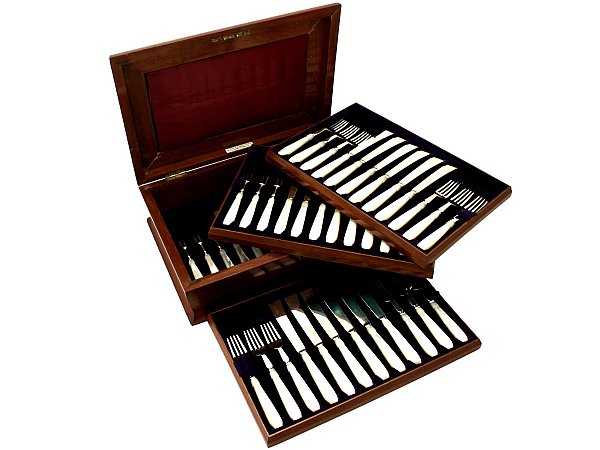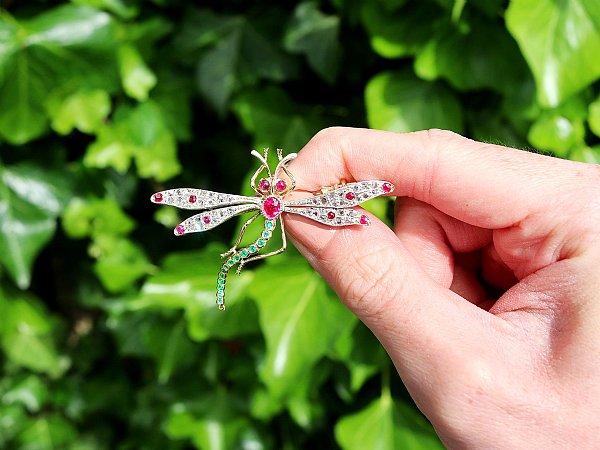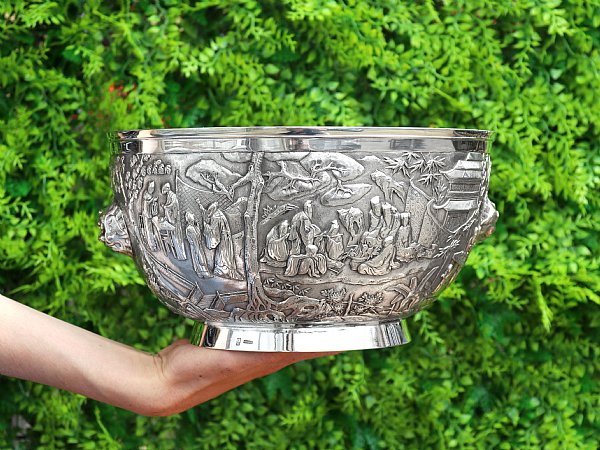Search Results for: '{{searchText}}'
Sorry...
We don't seem to have what you're looking for.
However we do have thousands of magnificent pieces of silver and jewellery available for you to view online. Browse our store using one of these categories.
Please wait for loading data... 
Sets of fruit or dessert knives and forks are often sold as services, and are sometimes considered interchangeable, as both dessert cutlery and fruit cutlery is smaller than regular table knives and forks, so they can easily be used to serve either course in a meal.
Fruit knives and forks are smaller than normal table cutlery, being created for eating more delicate courses, and dessert forks and knives are again even smaller than fruit forks, and were designed for eating the dainty, intricate confections that were fashionable during the Victorian era, when grand meals with separate courses became commonplace and were expected to be imposing and impressive.
We hope that you enjoy browsing our fine collection of antique silver cutlery sets and services, many of which are still offered in their original presentation boxes or with protective cutlery rolls.
Learn more about dessert etiquette

Antique silver flatware has a rich and fascinating history. Dessert spoons and forks have been a part of this since the mid-17th century, when they were made alongside larger pieces of cutlery. However, individual dessert sets did not come into use until the 1700s.
These sets were unique, as they were unlike much of the plainer flatware that was used for the earlier parts of each meal. Instead, they were often more ornate, featuring engraved fruit and flowers and elaborate gilding.
Pieces in dessert sets are smaller than normal table cutlery. This is because they were created for the purpose of being used during delicate courses, particularly the dainty, intricate confections that were fashionable during the Victorian era.
Initially, most sets contained only knives and forks for eating fruit and cheese. By the 19th century, however, dessert sets had become increasingly ostentatious.
At this time, it was fashionable to clear the dining table after the main courses of each meal. Servants would remove all of the used cutlery and replace it with a fresh set.
The introduction of this custom led to the development of new styles and designs of cutlery. The wealthy used this trend as an excuse to display their riches in the form of increasingly ornate dessert silver.
Patterns created during this time included Bacchanalian; this was used almost exclusively for dessert pieces. Many Victorian dessert services are surviving, and in excellent condition. This is perhaps because they are protected by the individually fitted boxes that a lot of them came in.
Other accessories included in dessert sets included pieces such as nut crackers and picks. These were not usually made out of silver as this was too soft- materials such as nickel- and silver-plated steel were the preferable options. Grape scissors were another popular addition to dessert sets. These are now highly sought after and collectable. The most elaborate designs of these were cast and chased with trailing vines or bunches of grapes.
Large silver spoons made for serving fruit compotes or sorbets were made to complement the smaller pieces in dessert sets. A popular 19th century trend was to convert plain tablespoons into ornate fruit spoons. These (and other items such as bowls) were embossed with flowers and fruit. Handles on bowls were reshaped and chased with heavy Rococo style decoration.
Many dessert pieces were made for table use. However, there was also a wide variety of accessories that were created specifically for travelling purposes. These included the folding fruit knife and the silver apple corer.
Sets of fruit or dessert knives and forks are often sold as services, and are sometimes considered interchangeable, as both dessert cutlery and fruit cutlery is smaller than regular table knives and forks, so they can easily be used to serve either course in a meal.




